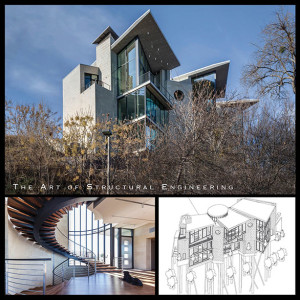Datum Engineers, Inc. was an Outstanding Award Winner for the Malone Cliff View Residence project in the 2015 NCSEA Annual Excellence in Structural Engineering awards program (Category – New Buildings under $10M).
This unique residence sits on the top of a bluff which originally was a 60-foot deep landfill of trash, tires, and more. The Architects design intent for the residence created three specific amazing views of the Dallas skyline. Parts of the house and balconies soar 17 feet out over the cliff with thin post-tensioned concrete slabs. These soaring cantilever floors accentuate the view in a dramatic way. The architectural centerpiece of the interior of the house is a two story spiraling steel stair which is also a part of the architectural appeal of the exterior of the house, as it can be seen through the glass window at the front entrance.

The site conditions, and desired architectural and functional expression, created numerous structural challenges not often found in residential construction. Four of these challenges were the major influence on the structural design concept.
First, the trash landfill created the need for deep vertical piers through the unstable fill to support the load of the residence, and battered piers to resist the horizontal sliding forces created by the bluff. A key to the success of the foundation was working closely with the contractor to identify sizes and location of both battered and vertical piers that could be accessed with special equipment. Finding the type of equipment that the contractor could drive out onto the bluff, and then designing the foundation around this restriction, was a major challenge. This was a difficult but successfully completed challenge with close teamwork between the structural engineer and the contractor.
Second, the only reasonable structural system that would accomplish the architect’s vision was a post-tensioned cast-in-place concrete slab. The architectural vision deserved thin concrete slabs. But, the thin slabs had to cantilever 17 feet. An added complication was that the cantilevered slabs needed to be supported on thin concrete slab bands that were formed flush to the bottom of the slab. Both the cantilevers and the slab bands were integrated into a 10-inch concrete slab with no drop beams. The concrete slab design and construction was further complicated at the roof, which was formed as a slight hyperbolic parabola. Engineering analysis of the post-tensioned cantilever slabs to prevent differential deflections that could lead to glass breakage at the ends of the cantilevers was a major tedious engineering effort. Deflections at the tips of the cantilevers varied depending on the length of the cantilever slab and the length of the supporting slab band. This required a thorough analysis of deflections at the tip of the cantilever and along the slab band to hold tight deflections and coordinate with the architect’s window wall details. No drop beams were used to stiffen the floor, in order to accommodate the air conditioning ducts and light fixtures in the low floor to floor height. Lee Christian P.E. used ADAPT-PT and ADAPT-Floor Pro software to analyze the slabs. Final measurements of deflections after construction were compatible with the calculations, and a successful solution to the architectural vision was accomplished.
Third, the two story architectural centerpiece stair was constructed of a single center-spiraling welded steel box beam that was only connected at each floor access point. Two cantilever steel cross plates, cut into the wood treads, were welded to the spiraling steel box beam, to support each tread. Structural considerations of a spiraling box beam and control of vibration characteristics, created a major analytical challenge to create an ultimately simple appearing, but structurally successful, architectural centerpiece. Craig Rios P.E. used SAP2000 to calculate the stresses, deflections and vibrations, and created a successful structural solution for the architectural centerpiece expression.
Fourth, originally there was no apparent method to support the circular steel roof over the stair without adding bulky columns behind the window wall. The ultimate solution to this structural challenge was to integrate small structural steel supporting tube columns into the glass exterior wall, eliminating any appearance of structural columns adjacent
to the window wall. The steel tubes became the window mullions in addition to supporting the steel roof. This wall of steel and glass was meticulously detailed, and kept as thin and lightweight as possible. This allowed for views of the centerpiece from the outside, let light in, and created a dramatic architectural entry to the residence.
A strong aspect of this award winning residence is its integration into the environment. The architectural vision, in large part, was made possible by the structural concept. A beautiful and dramatic home now sits on a bluff that was once a trash landfill.▪
